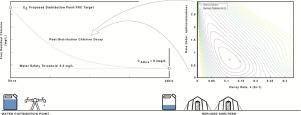Water Research ( IF 11.4 ) Pub Date : 2020-11-16 , DOI: 10.1016/j.watres.2020.116642 Syed Imran Ali , Syed Saad Ali , Jean-Francois Fesselet

|
The current Sphere guideline for water chlorination in humanitarian emergencies fails to reliably ensure household water safety in refugee camps. We investigated post-distribution chlorine decay and household water safety in refugee camps in South Sudan, Jordan, and Rwanda between 2013-2015 with the goal of demonstrating an approach for generating site-specific and evidence-based chlorination targets that better ensure household water safety than the status quo Sphere guideline. In each of four field studies we conducted, we observed how water quality changed between distribution and point of consumption. We implemented a nonlinear optimization approach for the novel technical challenge of modelling post-distribution chlorine decay in order to generate estimates on what free residual chlorine (FRC) levels must be at water distribution points, in order to provide adequate FRC protection up to the point of consumption in households many hours later at each site. The site-specific FRC targets developed through this modelling approach improved the proportion of households having sufficient chlorine residual (i.e., ≥0.2 mg/L FRC) at the point of consumption in three out of four field studies (South Sudan 2013, Jordan 2014, and Rwanda 2015). These sites tended to be hotter (i.e., average mid-afternoon air temperatures >30°C) and/or had poorer water, sanitation, and hygiene (WASH) conditions, contributing to considerable chlorine decay between distribution and consumption. Our modelling approach did not work as well where chlorine decay was small in absolute terms (Jordan 2015). In such settings, which were cooler (20 to 30°C) and had better WASH conditions, we found that the upper range of the current Sphere chlorination guideline (i.e., 0.5 mg/L FRC) provided sufficient residual chlorine for ensuring household water safety up to 24 hours post-distribution. Site-specific and evidence-based chlorination targets generated from post-distribution chlorine decay modelling could help improve household water safety and public health outcomes in refugee camp settings where the current Sphere chlorination guideline does not provide adequate residual protection. Water quality monitoring in refugee/IDP camps should shift focus from distribution points to household points of consumption in order to monitor if the intended public health goal of safe water at the point of consumption is being achieved.
中文翻译:

人道主义环境中家庭用水安全的循证氯化目标:来自南苏丹,约旦和卢旺达难民营的多点研究的建议
当前的Sphere人道主义紧急情况中的氯化水指南未能可靠地确保难民营的家庭用水安全。我们调查了2013-2015年之间南苏丹,约旦和卢旺达的难民营中分发后的氯衰减和家庭用水安全,目的是展示一种方法,以生成特定于现场和基于证据的氯化目标,从而更好地确保家庭用水安全而不是最新的Sphere指南。在我们进行的四个实地研究中,我们都观察到水质在分布和消费点之间如何变化。我们针对分配后的氯衰减建模的新技术挑战实施了非线性优化方法,以便估算出水分配点上的自由残留氯(FRC)水平必须为多少,为了在每个站点数小时后提供足够的FRC保护,直至达到家庭的消费点。通过这种建模方法制定的针对特定地点的FRC目标,在四分之三的实地研究中(南苏丹,2013年,约旦,2014年)提高了消费点具有足够氯残留(即,≥0.2mg / L FRC)的家庭的比例。和卢旺达(2015)。这些场所往往更热(即午后平均气温> 30°C)和/或水,环境卫生和个人卫生(WASH)条件较差,导致分布和消费之间的氯气大量衰减。在绝对值范围内氯衰减很小的情况下,我们的建模方法效果不佳(Jordan 2015)。在这样的环境中(凉爽(20至30°C),并且具有更好的WASH条件),我们发现当前Sphere氯化指南的上限(即0.5 mg / L FRC)提供了足够的残留氯,以确保分配后24小时内的家庭用水安全。分布后的氯衰减模型产生的针对特定地点和基于证据的氯化目标可以帮助改善难民营环境中的家庭用水安全和公共卫生结果,因为目前的球形氯化准则并未提供足够的残余保护。难民/国内流离失所者营地的水质监测应将重点从分配点转移到家庭消费点,以便监测是否在消费点实现了预期的安全饮水公共卫生目标。5 mg / L FRC)提供了足够的残留氯,以确保分配后24小时内的家庭用水安全。分布后的氯衰减模型产生的针对特定地点和基于证据的氯化目标可以帮助改善难民营环境中的家庭用水安全和公共卫生结果,因为目前的球形氯化准则并未提供足够的残余保护。难民/国内流离失所者营地的水质监测应将重点从分配点转移到家庭消费点,以便监测是否在消费点实现了预期的安全饮水公共卫生目标。5 mg / L FRC)提供了足够的残留氯,以确保分配后24小时内的家庭用水安全。分布后的氯衰减模型产生的针对特定地点和基于证据的氯化目标可以帮助改善难民营环境中的家庭用水安全和公共卫生结果,因为目前的球形氯化准则并未提供足够的残余保护。难民/国内流离失所者营地的水质监测应将重点从分配点转移到家庭消费点,以便监测是否在消费点实现了预期的安全饮水公共卫生目标。分布后的氯衰减模型产生的针对特定地点和基于证据的氯化目标可以帮助改善难民营环境中的家庭用水安全和公共卫生结果,因为目前的球形氯化准则并未提供足够的残余保护。难民/国内流离失所者营地的水质监测应将重点从分配点转移到家庭消费点,以便监测是否在消费点实现了预期的安全饮水公共卫生目标。分布后的氯衰减模型产生的针对特定地点和基于证据的氯化目标可以帮助改善难民营环境中的家庭用水安全和公共卫生结果,因为目前的球形氯化准则并未提供足够的残余保护。难民/国内流离失所者营地的水质监测应将重点从分配点转移到家庭消费点,以便监测是否在消费点实现了预期的安全饮水公共卫生目标。











































 京公网安备 11010802027423号
京公网安备 11010802027423号